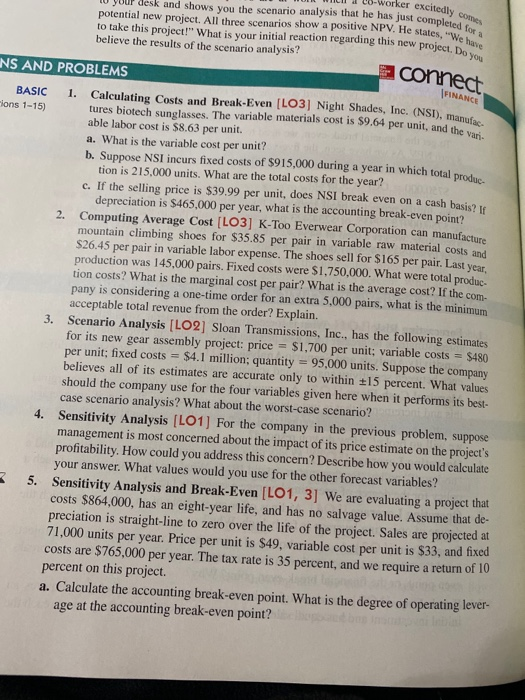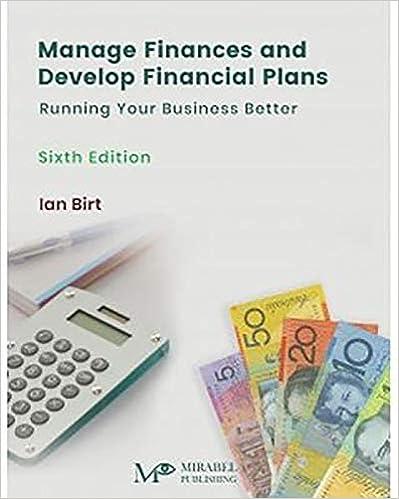My queation is question 5 , sensitivity analysis and break even , parts b ans c continue to another page , thank you so much !

20-worker excitedly so ANCOS IU your desk and shows you the scenario analysis that he has just comple potential new project. All three scenarios show a positive NPV. He states, to take this project!" What is your initial reaction regarding this new project, believe the results of the scenario analysis? completed for a . We have ject. Do you NS AND PROBLEMS E connect FINANCE er unit, and the vari BASIC 1. Calculating Costs and Break-Even [LO3] Night Shades, Inc. (NSI), m Lions 1-15) tures biotech sunglasses. The variable materials cost is $9.64 per unit, and th able labor cost is $8.63 per unit. a. What is the variable cost per unit? b. Suppose NSI incurs fixed costs of $915,000 during a year in which total pro tion is 215.000 units. What are the total costs for the year? c. If the selling price is $39.99 per unit, does NSI break even on a cash basist depreciation is $465,000 per year, what is the accounting break-even point? 2. Computing Average Cost (LO3) K-Too Everwear Corporation can manufacture mountain climbing shoes for $35.85 per pair in variable raw material costs and $26.45 per pair in variable labor expense. The shoes sell for $165 per pair. Last year, production was 145,000 pairs. Fixed costs were $1,750,000. What were total produc. tion costs? What is the marginal cost per pair? What is the average cost? If the com- pany is considering a one-time order for an extra 5,000 pairs, what is the minimum acceptable total revenue from the order? Explain. 3. Scenario Analysis [LO2] Sloan Transmissions, Inc., has the following estimates for its new gear assembly project: price = $1,700 per unit; variable costs = $480 per unit; fixed costs = $4.1 million; quantity = 95,000 units. Suppose the company believes all of its estimates are accurate only to within 15 percent. What values should the company use for the four variables given here when it performs its best- case scenario analysis? What about the worst-case scenario? 4. Sensitivity Analysis [LO1J For the company in the previous problem, suppose management is most concerned about the impact of its price estimate on the project's profitability. How could you address this concern? Describe how you would calculate your answer. What values would you use for the other forecast variables? 3 5. Sensitivity Analysis and Break-Even (LO1, 3] We are evaluating a project that costs $864,000, has an eight-year life, and has no salvage value. Assume that de- preciation is straight-line to zero over the life of the project. Sales are projected at 71,000 units per year. Price per unit is $49, variable cost per unit is $33, and fixed costs are $765,000 per year. The tax rate is 35 percent, and we require a return of 10 percent on this project. a. Calculate the accounting break-even point. What is the degree of operating lever age at the accounting break-even point? Chapter 11 Project Analysis and Evaluation b. Calculate the base-case cash flow and NPV. What is the sensitivity of NPV to changes in the sales figure? Explain what your answer tells you about a 500-unit decrease in projected sales. What is the sensitivity of OCF to changes in the variable cost figure? Explain what your answer tells you about a $1 decrease in estimated variable costs. Scenario Analysis (LO2] In the previous problem, suppose the projections given for price, quantity, variable costs, and fixed costs are all accurate to within 10 per- cent. Calculate the best-case and worst-case NPV figures. 7. Calculating Break-Even [LO3] In each of the following cases, calculate the ac counting break-even and the cash break-even points. Ignore any tax effects in calcu. lating the cash break-even. Unit Price $2,980 46 Unit Variable Cost $2,135 41 Fixed Costs $9,000,000 135,000 1,900 Depreciation $3,100,000 183,000 930 8. Calculating Break-Even (LO3] In each of the following cases, find the unknown variable: Depreciation Unit Price Accounting Break-Even 97,432 165,000 19,530 Unit Variable Cost $30 27 $39 Fixed Costs $ 820,000 2,745,000 237,000 $1,150,000 138.900 92 9. Calculating Break = 12 percent; initial culating Break-Even (LO3) A project has the following estimated data: price per unit: variable costs = $36 per unit: fixed costs = $19,300; required return crcent; initial investment = $26.800; life = four years. Ignoring the effect of what is the accounting break-even quantity? The cash break-even quantity? cial break-even quantity? What is the degree of operating leverage at the The financial break mancial break-even level of output? Using Break-Eve units: life reak-Even Analysis (LO3] Consider a project with the following data: break-even quantity = 14,200 units; cash break-even quantity = 10,300 fired costs = $170,000: variable costs = $27 per unit; re- ror find the financial break-even









